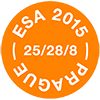Guidelines for Poster Session
The poster is an important method for presenting research information at a conference and has many advantages over oral presentation, including interaction on a one-to-one basis with interested delegates, images and data that can have a greater influence than transparencies fleetingly glimpsed in an oral presentation and where English is not fluently spoken, a more effective method of communication.
The poster area will be located in the C building (2nd floor) of the Faculty of Civil Engineering (FCE).
Posters presentations are scheduled on the 26th, 27th and 28st August from 12:45 till 13:45. There will be three poster sessions in a whole. There will be an assistant ready to help you every day from 10:00 to 14:00. Presenters are allowed to display their posters for a whole day. Pins will be provided at the poster area.
Posters will be grouped by RN/RS, thus posters dealing with similar topics will be put nearby and enumerate with consecutive numbers with the aim of stimulating the debate increasing among researchers, coordinators and participants working on similar topics.
The following guidelines should help you prepare effective and successful posters.
Preparing the Poster
Design your poster to be as eye-catching and attractive as possible and where possible illustrate with a figure, chart or photograph rather than text. The basic rule is to keep it simple, do not clutter, do not include unnecessary data, make everything bold and large, and try and get your message across to the non-experts as well as experts in your field. Prepare the poster in portrait format.
Poster size is A0 however it can be made of more smaller pieces.
Figures, Charts and Photographs
Figures, charts and photographs should be made as large and of as good a quality as possible. Labels or arrows should be bold and easily seen. Contrasting mounting card and a coloured background are eye-catching assets. A mixture of different coloured backgrounds can also be very effective but too many colours, type styles or images can be confusing to those reading the poster information.
The Title
The title must be large and clear enough to be read from about 5 metres. Keep the title short and the letters bold, preferably solid-block and at least 5 cm high and as far as possible attention grabbing, for example by posing a question. Some authors include the logo of their institution or organisation and their own photo, which can be very helpful if the author is to be identified at the poster session.
The Text
The text should be concise, legible and easily comprehended. Traditionally, the poster should include an abstract, short introduction, aims of the study, results and discussion/conclusions. These should be presented as short ‘bullet’ lists rather than paragraphs of text. Do not overwhelm the viewer with masses of tables and data. Quantitative data can be presented as histograms, pie charts or line or bar graphs. Qualitative data can be presented as quotes, excerpts from publications (e.g. newspapers, magazines, official documents) or even as photographs or maps. The lettering of the text must be large and legible at up to 2 m.
- Title should be in bold. Author’s affiliations and e-mail addresses for should be included.
- Text: a poster should be easily readable from a distance of 1 – 2 metres, and 1.5 or 2 lines of spaces should be used between each line.
- Headings should be 25% larger than normal text. Bold or other colours may be used.
- Suggested font sizes are (for the A0 format):
Main title: 78 pt (bold, upper case)
Author: 72 pt (bold, title case)
Affiliation(s): 48 pt (normal, title case)
Email address: 36 pt (bold)
Subheading: 36 pt (bold upper case)
Body of text: 24 pt (normal)
Smaller fonts may be used in citations and acknowledgement. The amount of text should be kept to a minimum, and each block of text should include no more than a few sentences. Visual impact is important and you are encouraged to include colour images and background.
Transporting the Poster
If you prepare your poster in the final form, you will just need to come and hang it up. This, however, may mean ‘lugging’ a gigantic package of unwieldy and uncomfortable dimensions. It is much easier, to prepare your poster on cards that fit into an oversized envelope that you could place at the bottom of your suitcase and pin up on arrival. It is vital that they are well mounted on cards to ensure that they lie flat. By far the best means of doing this is to have your poster laminated and transport it in a plastic or other sturdy tube.
If you are transporting your poster in your luggage, be aware that luggage has been known to get lost. It might be a good idea to make a duplicate poster and leave it in the care of someone who you can be in touch with easily and who can ship it to you via overnight delivery.
Printing On-site
If you consider printing your poster on-site, there is a Copy Centre available in FCE building on the 1st floor. It is marked in the maps of the conference venue as well.
Copy Centre (accepts payment in cash only - CZK)
Opening hours:
Tue 25/8 – 10:00 – 19:00
Wed 26/8 – Fri 28/8 – 8:00 – 19:00
Price: A0 (80g paper, colour) - 200 CZK, A0 (80g paper, b/w) - 64 CZK, A0 (quality photopaper, colour) - 600 CZK.






